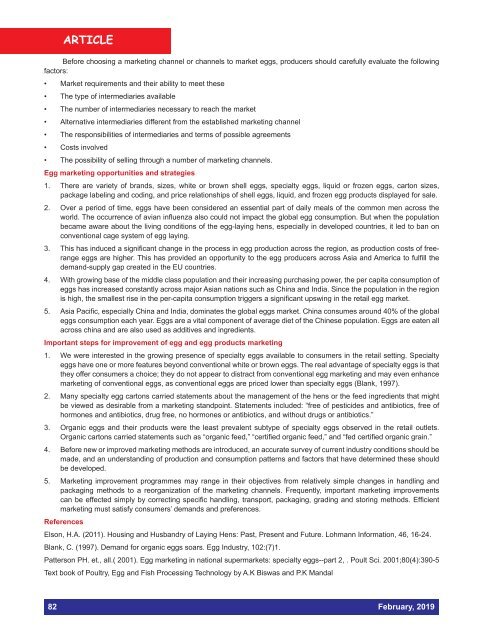POULTRY PUNCH - FEBRUARY 2019
POULTRY PUNCH - FEBRUARY 2019
POULTRY PUNCH - FEBRUARY 2019
- No tags were found...
You also want an ePaper? Increase the reach of your titles
YUMPU automatically turns print PDFs into web optimized ePapers that Google loves.
ARTICLE<br />
NEWS<br />
Before choosing a marketing channel or channels to market eggs, producers should carefully evaluate the following<br />
factors:<br />
• Market requirements and their ability to meet these<br />
• The type of intermediaries available<br />
• The number of intermediaries necessary to reach the market<br />
• Alternative intermediaries different from the established marketing channel<br />
• The responsibilities of intermediaries and terms of possible agreements<br />
• Costs involved<br />
• The possibility of selling through a number of marketing channels.<br />
Egg marketing opportunities and strategies<br />
1. There are variety of brands, sizes, white or brown shell eggs, specialty eggs, liquid or frozen eggs, carton sizes,<br />
package labeling and coding, and price relationships of shell eggs, liquid, and frozen egg products displayed for sale.<br />
2. Over a period of time, eggs have been considered an essential part of daily meals of the common men across the<br />
world. The occurrence of avian influenza also could not impact the global egg consumption. But when the population<br />
became aware about the living conditions of the egg-laying hens, especially in developed countries, it led to ban on<br />
conventional cage system of egg laying.<br />
3. This has induced a significant change in the process in egg production across the region, as production costs of freerange<br />
eggs are higher. This has provided an opportunity to the egg producers across Asia and America to fulfill the<br />
demand-supply gap created in the EU countries.<br />
4. With growing base of the middle class population and their increasing purchasing power, the per capita consumption of<br />
eggs has increased constantly across major Asian nations such as China and India. Since the population in the region<br />
is high, the smallest rise in the per-capita consumption triggers a significant upswing in the retail egg market.<br />
5. Asia Pacific, especially China and India, dominates the global eggs market. China consumes around 40% of the global<br />
eggs consumption each year. Eggs are a vital component of average diet of the Chinese population. Eggs are eaten all<br />
across china and are also used as additives and ingredients.<br />
Important steps for improvement of egg and egg products marketing<br />
1. We were interested in the growing presence of specialty eggs available to consumers in the retail setting. Specialty<br />
eggs have one or more features beyond conventional white or brown eggs. The real advantage of specialty eggs is that<br />
they offer consumers a choice; they do not appear to distract from conventional egg marketing and may even enhance<br />
marketing of conventional eggs, as conventional eggs are priced lower than specialty eggs (Blank, 1997).<br />
2. Many specialty egg cartons carried statements about the management of the hens or the feed ingredients that might<br />
be viewed as desirable from a marketing standpoint. Statements included: “free of pesticides and antibiotics, free of<br />
hormones and antibiotics, drug free, no hormones or antibiotics, and without drugs or antibiotics.”<br />
3. Organic eggs and their products were the least prevalent subtype of specialty eggs observed in the retail outlets.<br />
Organic cartons carried statements such as “organic feed,” “certified organic feed,” and “fed certified organic grain.”<br />
4. Before new or improved marketing methods are introduced, an accurate survey of current industry conditions should be<br />
made, and an understanding of production and consumption patterns and factors that have determined these should<br />
be developed.<br />
5. Marketing improvement programmes may range in their objectives from relatively simple changes in handling and<br />
packaging methods to a reorganization of the marketing channels. Frequently, important marketing improvements<br />
can be effected simply by correcting specific handling, transport, packaging, grading and storing methods. Efficient<br />
marketing must satisfy consumers’ demands and preferences.<br />
References<br />
Elson, H.A. (2011). Housing and Husbandry of Laying Hens: Past, Present and Future. Lohmann Information, 46, 16-24.<br />
Blank, C. (1997). Demand for organic eggs soars. Egg Industry, 102:(7)1.<br />
Patterson PH. et., all.( 2001). Egg marketing in national supermarkets: specialty eggs--part 2, . Poult Sci. 2001;80(4):390-5<br />
Text book of Poultry, Egg and Fish Processing Technology by A.K Biswas and P.K Mandal<br />
82 February, <strong>2019</strong>






